This article concerns leather footwear and how to repair it when necessary.
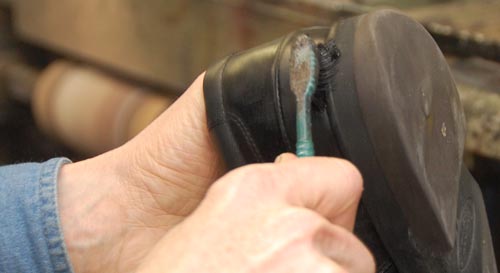 Introduction to Leather Shoe Repair
Introduction to Leather Shoe Repair
A well-made pair of shoes is the foundation of a man’s ensemble. They are what a smart look stands on, so to speak.
Shoes are likely to be the most expensive article on your person
beside your wedding band. That said, these shoes meet your investment
and return you years of looking sharp.
Finding a great pair of shoes can be a task or opportunity to
splurge. As a teenager with what I thought was impeccable taste, I would
ratchet up a huge bill on online auctions for British footwear. I bid
on patent leather Paolo Vandini winklepickers, suede Chelsea boots, and
red snakeskin boots a la Vincent Gallo. These shoes were a bit out of my
budget, but I figured they were worth every shilling in the long run.
There was no “long run” after all.
Many of these shoes were ruined because of my lack of maintenance. I
have learned a lot since then now that shoes in my closet have lasted
years not seasons. The wear-and-tear of daily use and the occasional
step on your blue suede is inevitable, but using a few easy methods
should keep shoes looking great through rain or shine.
 Leather Shoe Repair
Leather Shoe Repair
It really pays to know your local cobbler or shoe repairer.
Here in Madison, I have told everyone with an ear to lend and shoes
to fix about Franco the cobbler. He has cornered the local market on
shoe repair with his know-how and ability to fix the saddest looking
leather shoes you can throw at him. The aptly titled Franco Shoe Repair
is on 1213 Regent Street in Madison, WI.
We’d also like to thank Paul Herwaldt for his help on this article –
he is a third generation cobbler who owns Shoe Repair Plus in Green Bay,
WI. Paul performs shoe repair via mail at a fair price – highly
recommended for those of you who do not have access to a local cobbler.
Weatherproofing New Shoes
You might ask, ‘Aren’t my shoes already weatherproofed?’
Yes, your shoes are already weatherproofed when you first put them
on. If a new pair of shoes came with a disclaimer, it would tell you
that the first round in weatherproofing is provided and the next round
is up to you.
I compare the first weatherproofing to the top coat of wax on a new
car. It is only going to look that sexy for so long after you roll it
off lot until you put on your own coat when necessary.
You might also ask ‘How are my leather shoes effected by water?’
Water can and will destroy the suppleness of your shoe’s leather.
Breaking in your shoe is desirable to mold to the form of your
particular foot, but water warps the shape of the shoe in an undesirable
way.
Leather footwear can manage tens of thousands of flexes. A
persistently wet and dried shoe will only last a fraction of these uses.
Leather is nothing but animal skin (most often cattle or horse) which
is made up of fat and proteins can only retain a set amount of moisture
after being cured and tanned. The fibers that criss-cross each other in
the corium, or the hide, give leather its unique strength, but are also
very susceptible to drying out and cracking if not treated with care.
I do recommend that you condition your leather footwear – this
ensures the leather maintains the right level of moisture to prevent
cracking. Two brands I have used and endorse are
Leather Honey &
Chamberlain’s leather conditioner.
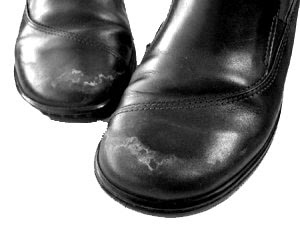 Protecting New Shoes Against Salt
Protecting New Shoes Against Salt
Walking around a Midwestern city in the slushy winter months will certainly expose any leather owner’s shoes to road salt.
For others in warmer climates, shoes are threatened by lesser hazards
like sand and lime. Like salt, these can be harsh in prematurely
wearing out your leather, but are less difficult to remove once they
permeate or scuff the leather itself. If left untreated, the salt will
discolor and weaken the finish of the shoe.
This is also something to keep in mind if purchasing a secondhand pair because of the nature of the set-in salt stain.
A thin layer of waxy polish between the leather and these harmful
elements could be the difference between a one minute cleaning versus a
costly trip to the cobbler.
I most recommend beeswax because of its ability to cover all tones or
colors and it is not as noxious as Kiwi polish and other leading
brands. However anything is better than nothing when dealing with slush
and snow.
Note: simply using a damp cloth does not thoroughly remove that salt ring from the toe of your shoe after it has dried.
Owning an expensive leather shoe is slightly demanding. Be mindful of
how often your shoes get wet then dry out, or become exposed to
alkalines, acids, and salts all of which can erode your shoe and your
hard-earned shoe budget.
Repairing Leather Shoes On Your Own
You might have the impulse to go out and buy a quick fix. The whole
idea of maintaining shoes is not adding to the pile of shoe expenses.
No amount of polish or “waterproofing” spray is going to keep out
water if you are continuously walking in rain. However, you will need
some store-bought implements in keeping your shoes looking great for
years.
The single-use products that are on the market today (one-use shoe
polishes with applicators, shine wipes, etc.) are ultimately more
expensive and less effective in the long haul. My father still uses an
old clapboard shoe-shining kit containing polishes and bristle brushes. A
bristle brush, a rag, and one or two tins of a neutral colored, trusted
brand of polish is the best place to start.
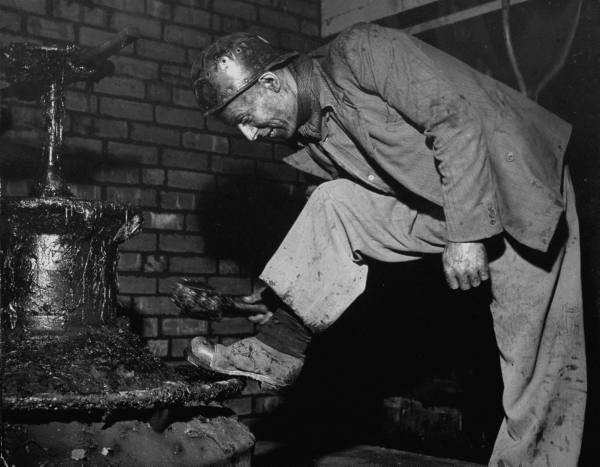 1. Select a Waterproofing Compound
1. Select a Waterproofing Compound
There is a lot of debate on the subject of which waterproofing
compound is most effective. Just like other consumer products, there is
quite a vast market of shoe compounds out there to consider. But not all
of these products in the shoe care section are just polishes; many
products have enhanced formulas for specific kinds of footwear.
Wax-based Polishes – Unlike shoe pastes and creams,
which are designed more to nourish the leather, wax-based polishes are
made to create a shine and by doing so create a superficial protective
layer than can provide light resistance to water and salt. Manufacturers
such as
Lincoln make a good product, along with
Meltonian
who also provides their polish in a wide range of colors. The key to
this type of protection is consistent application after every few wears,
or every wear if the weather is particularly wet. This is the most
high-maintenance approach.
Specialty Waterproof Compounds –
Chamberlain’s Water Protectant,
Obenauf’s Heavy Duty Leather Preservative and
Sno-Seal Weather Protectant
are just three examples of waterproofing compounds whose main purpose
is protection. They do a solid job when applied properly and have a
longer sticking period than polishes because it is an industrial-grade
product. Unlike the above mentioned compounds, these protectants do not
create a shine but rather to seal out moisture; as such they may need to
be used in conjunction with a polish once the seal has been set. If you
have to combine a protectant with a polish, make sure you follow Step 2
closely.
Spray-on Waterproofing Compounds – Of all the
waterproofing techniques, this one receives the most amount of flack.
Common arguments are that it doesn’t allow the leather to breath and
that if the compound contains silicone it will dry out the leather.
My stance is if ease of use is your concern, then it’s much
better to use a spray on waterproofing than nothing at all.
Companies such as Meltonian make a water-and-stain protector that is
safe to use on leather and suede and is dry and ready 30 minutes. These
waterproofing sprays should be used liberally, as they lose their
effectiveness after only a few wears. They are not meant to penetrate
the leather, but rather provide a protective glaze.
2. Test & Prepare for Waterproofing
This next step is crucial for any shoe that is not black. This
process is meant to retain the original appearance of the shoe, and you
don’t want to mistakenly discolor the shoe.
If you haven’t already, remove the laces and thoroughly clean the
shoe with a brush and rag to remove dirt. Be advised not to assume the
color match guarantee made by the manufacturer will hold up. You don’t
want to be an exception to the rule.
Choose a discreet part of your shoe, such as the side of the shoe’s
tongue under the laces, and apply a small amount to see how it reacts.
After you are more confident, move to an area like the inner back of
the shoe and test again. Remember, the tech-ed rule applies here: test
twice so you can do the right job once.
3. Applying the Protectant
The only difference in applying a waterproof compound versus a
shining compound is the distribution of the product on your shoe. When
shining your shoes you can spot shine on occasion – when waterproofing
you need to ensure a water tight barrier is formed or the whole process
is for naught.
Durable Men’s Shoe Suggestions
Specialty Footwear – There are many companies that
make solid footwear using water resistant materials such as gortex,
synthetic leathers, and non-slip rubber soles. Although they are not on
the same level as higher end men’s shoes and do not offer as much
protection as galoshes, their stylish design and inclement weather
durability make them a favorite among practical men. An example is the
ECCO Berlin GTX. Its large sole and open laced design make it a less
dressy shoe than a classic oxford. But when it comes to not having to
worry about the rain or snow and for the man who does not want to be
hassled with multiple pairs of shoes, these a staple.
Boots – From hiking to work, boots are made to be
tougher and are a great choice for inclement weather thanks to their
height and ability to protect the ankles. Unfortunately they are limited
in the range of clothing they can be worn with; anything dressier than
odd trousers is stretching their boundaries. Although the dress boot has
a wider range and can be worn with a mens suit, it provides less
protection than its brawnier brethren. Due to its thinner sole and
smaller heel you’ll have less clearance when traversing puddles and thus
dress boots should be worn with as much care as dress shoes. With all
that being said, all boots should be treated regularly with a
waterproofing compound depending on the wearers environment and
frequency of wear.
Galoshes – Galoshes are rubber footwear that slip
over shoes and protect them from the elements. Galoshes are a good
choice because because they are now sleek and easily incorporated with
dressier wardrobes. The term includes both over-shoes and over-boots,
the difference being the amount of coverage around the footwear. With a
history of serving men (and women) for over 100 years, they have
perfected the art of keeping the wearer dry by completely encapsulating
the feet and as an added bonus often provide excellent traction. Their
downside is that proper fit is absolutely necessary.
A good pair of new galoshes can range in price from $20 to well over
$150, the difference being durability and style although a very solid
pair for occasional wear can be found for less than $30. Companies like
Swim offer a wide range of durable and stylish galoshes online. For the
gentleman who walks through all weather, a sturdy pair of galoshes can
prove to be invaluable.
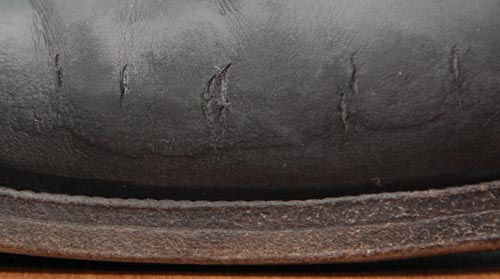
Read this last section or this could happen to you!
How To Dry Wet Shoes
In closing this article, I want to address the inevitable question of
what to do when your shoes get wet. Despite all of your planning,
you’re bound to get caught in the rain once!
Wick off the water right away or use a dry rag or towel if available
to wipe off the water. Pull the moisture from the inside of the shoe.
This can be done with newspaper or a small dry towel. The key is to draw
the moisture out, so every hour or so replace the moist paper with dry
paper. Depending on the extent of the soaking, this could take from two
hours to two days.
Despite what you might think, leaving your shoes next to a heat
source only makes the problem worse. Let them dry slowly at room
temperature. If you heat them you will cause the moisture to leave too
quickly and greatly increase the chance of the leather cracking. Cracked
leather can not be repaired.
Once the shoes appear dry and no more moisture is being drawn out of
the shoe, clean and condition with a leather balm or cream and finally
polish as usual.
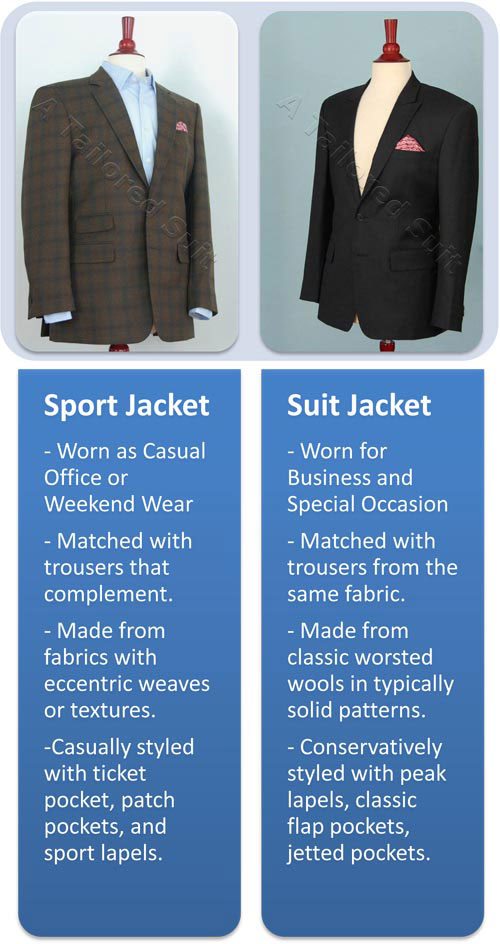
 Introduction to Leather Shoe Repair
Introduction to Leather Shoe Repair Leather Shoe Repair
Leather Shoe Repair Protecting New Shoes Against Salt
Protecting New Shoes Against Salt
